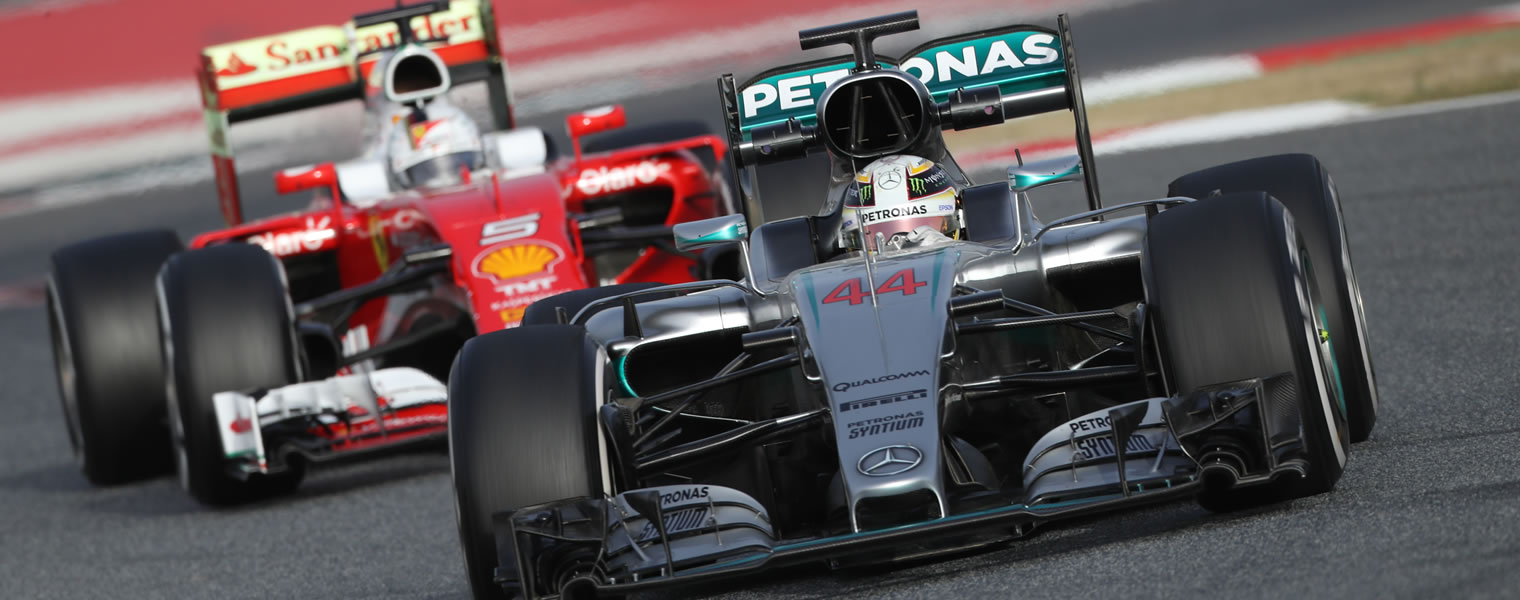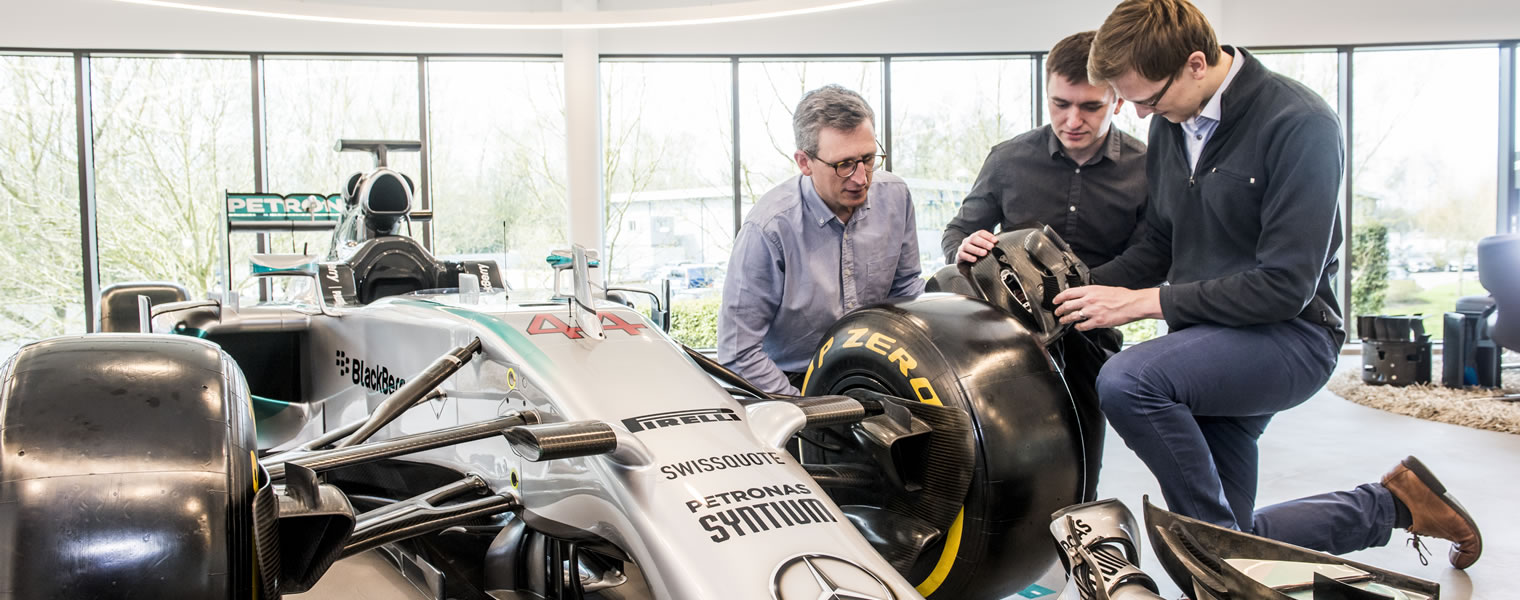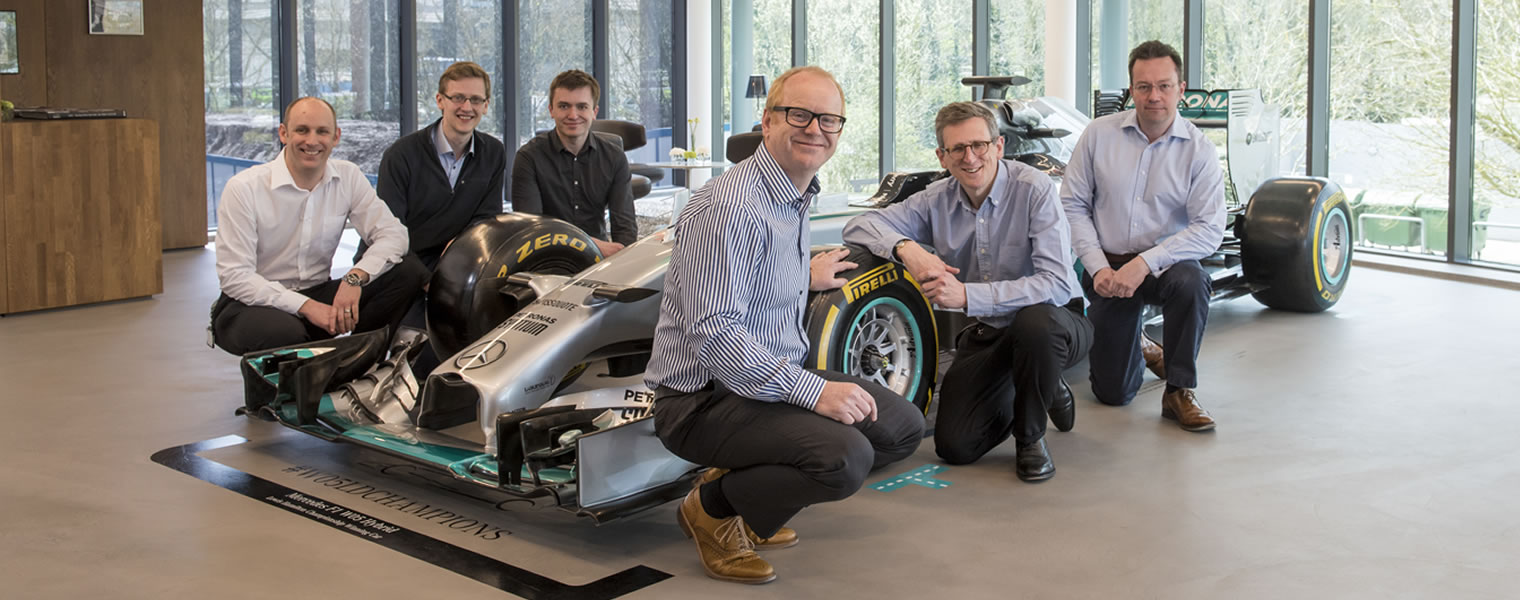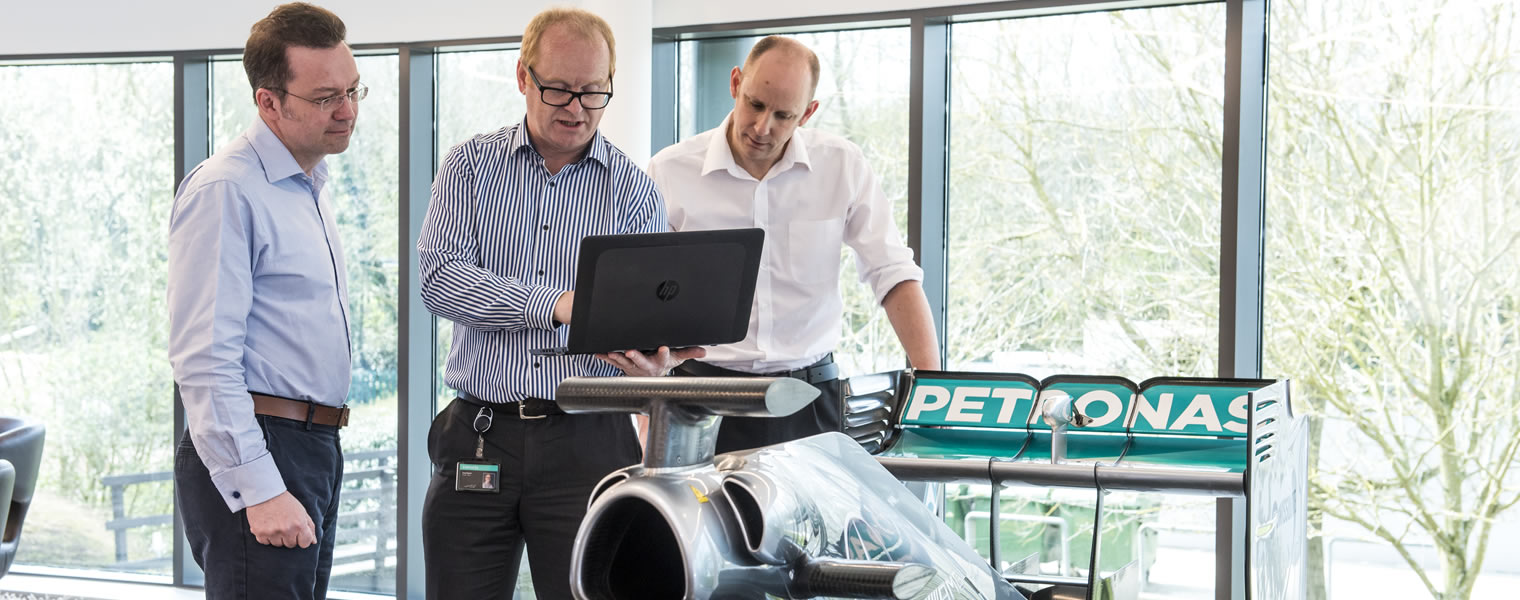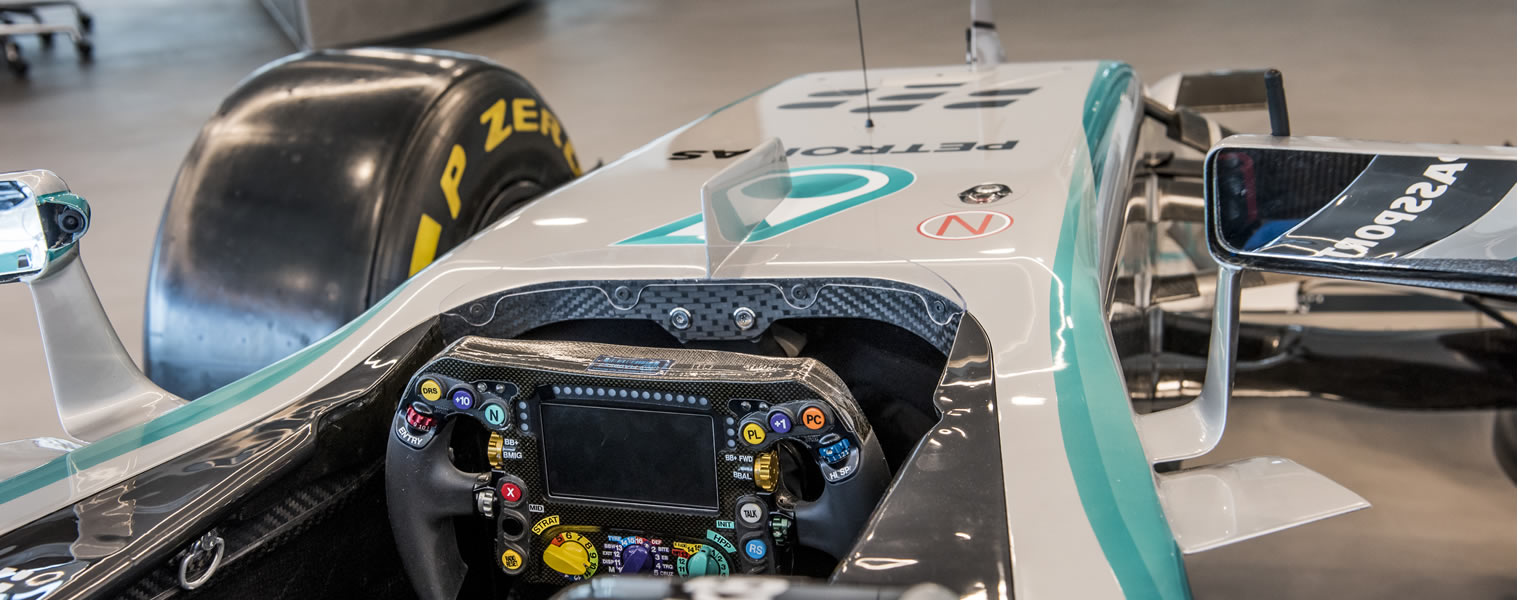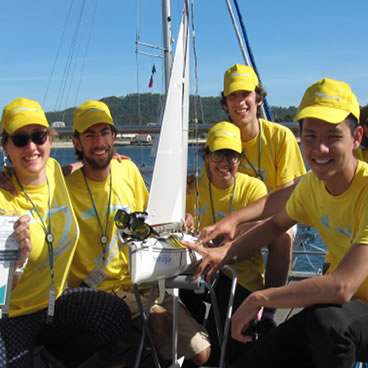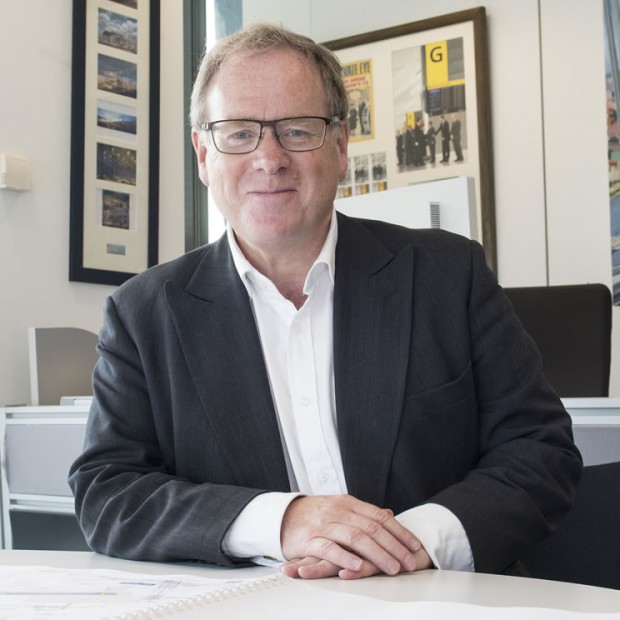Hartley News Online Your alumni and supporter magazine
Southampton graduates are contributing to the ongoing success of Mercedes in Formula One (F1) racing
Over the last three F1 Grand Prix racing seasons, the team from Mercedes AMG Petronas has taken the chequered flag more times than any other.
Drivers Lewis Hamilton and Nico Rosberg have underlined Mercedes’ dominance by finishing first and second in the Drivers’ Championship for two consecutive seasons with the team also taking back-to-back Constructors’ Championships.
Southampton alumni enjoy F1 success
Once again in 2016, Mercedes leads from the front with Rosberg winning the first four F1 races and Hamilton not far behind. And every time a Mercedes car takes the chequered flag, Southampton alumni join the celebrations; each one a contributor as part of the driving force behind the team’s success on F1 circuits around the world.
David Jeffrey, Dan Mulvaney, Brendan McFall, Greg Rapson, James Chaldecott and Julian Hodgson are among a number of Southampton graduates now working at Mercedes and continuing a legacy of the University’s engagement in F1 that began decades ago.
Among its many credits in auto racing, the University of Southampton is recognised as a leader in ground effect aerodynamics. Advanced wind tunnel technology developed at the University provided facilities and expertise for several UK F1 teams in the 1980s and 1990s with world championship cars developed in Southampton for Brabham, Tyrell and Williams.
Southampton has also responded to the needs of F1 teams by working with them to develop and introduce a unique course, MSc Race Car Aerodynamics, aimed at graduates and similarly qualified individuals from engineering, scientific or mathematical backgrounds, who want advanced specialisation in race car aerodynamics.
Today, Southampton graduates work across virtually every team in F1, perpetuated by a combination of the University’s reputation within the sport and a successful PhD programme and industrial placements helping many to secure a position in F1. Success or failure in F1 racing is often dependent upon very small margins, which can prove decisive in a single race and, ultimately, over the course of a full season. The talents of Southampton’s graduates working for Mercedes are a key reason that the team is enjoying such a period of notable success at the moment.
Continuously enhancing capability
For David Jeffrey (PhD Aerodynamics, 1998), Aerodynamics Group Manager at Mercedes AMG Petronas, the road began with the inception of the team 18 years ago and has led to a range of roles.
“When I started, I was one of only two aerodynamicists, working very much hands-on in the wind tunnel,” David recalls. “My current role is all about making sure that the Aerodynamics Department recruits and develops the best engineers and that we are continually enhancing our capability.
Essentially it’s about making sure that engineers like Dan Mulvaney (MEng Aerospace Engineering 2010; PhD Fluid Dynamics 2016) and Brendan McFall (MEng Aeronautics and Astronautics, 2014) have got the platform to do what they do best – make our current and future cars go faster.
David acknowledges Southampton’s proud reputation for providing world-beating engineers, and explains that the University remains one of the principal places his team looks to when hunting for new engineering talent.
“Every year the team recruits from top universities – including Southampton – a number of engineering graduates to join our design team and, at the same time, we also take on a handful of undergraduates, usually between their third and fourth years,” he says. “They spend 13 months on our Industrial Placement scheme before returning to complete their academic studies. While our placement students are not guaranteed a job at the end, a number have gone on to work for the team, while many others have found that it has helped them secure a position elsewhere on the grid.
“I can remember a few years back, when we first started doing milk round presentations and telling rooms full of students that our aim was to win multiple championships,” David recounts. “At the time I was concerned the students might think we were being unrealistic: our on-track performances were respectable, but not in the very top echelon. So it is hugely satisfying to have played a small part in putting together the team of people who have delivered on that vision.
Sharp end of racing
According to David, the engineers he recruits fall into two camps. The first have aspired to work in F1 since before university and the second have a deep passion for engineering. “They see that F1 offers a chance to prove yourself in a competitive environment, with rapid turnaround from concept to reality, access to cutting-edge facilities and the opportunity to work alongside other highly-motivated individuals in a team environment,” David says.
“I fell into the second camp: my first steps as an aerodynamicist were in the aircraft industry, but the constant restructuring of the industry and history of cancelled projects prompted me to rethink my career. I decided to go to Southampton to study a PhD in race car aerodynamics, which became my springboard for getting into F1.”
Brendan, now an aerodynamicist at Mercedes, was one of many Southampton students recruited for an industrial placement with the team, from July 2012–2013.
“As a placement student, you get the chance to be fully immersed in the F1 environment and develop your skills in many different areas of race car development,” he enthuses. “I learned how to use CAD software to design complex components, how to mesh, run and analyse computational fluid dynamics (CFD) results, and how to plan and execute wind tunnel tests.
“Students can also get the chance to help out in the factory’s race support room during race weekends, contributing to real-time analysis of track data while communicating via headset with engineers who can be on the other side of the world – this is a great opportunity to see the ‘sharp end’ of racing and helps put all the other work you do into context,” Brendan adds. “Students are treated as full members of the team, so they will be given proper jobs to do and real responsibility, which of course also means real pressure!”
Fellow Aerodynamicist Dan is following his dream. Having long wanted to work in F1, his time at Mercedes has enhanced his enthusiasm for the sport. His work is currently focused on generating and developing ideas for the vehicle’s aerodynamic surfaces using CAD and taking those ideas forward to test and assess in the team’s wind tunnel with the best of those making it to the final race car.
“It’s a very proud feeling seeing your ideas on-track,” he says. “There is a genuine feel that, to many of the people working here, the job is also a hobby, which helps keep the motivation up even when the hours can be long and the work can be challenging. The titles have helped as now the team has them, there is an extra motivation to not let them slip away.”
Ideas from concept to reality
Brendan echoes Dan’s excitement in seeing his designs go from concept to reality. “If one of your designs shows promise, you could see it turn up at a race as part of an upgrade package within a manner of weeks,” he says. “The first time one of my parts made it to the race car was definitely a highlight – seeing your designs on TV and hopefully watching them perform well on track gives a real buzz!”
David adds: “The race wins and championships are great, but as an aerodynamicist the real buzz is when you finally get a concept to work: that moment when you get the first results from CFD or the wind-tunnel that tell you that you have unlocked a new area of performance. In my organisational role, I get comparable moments when I recruit an outstanding candidate or see new capabilities being used to improve racecar performance.”
That ability to achieve through problem-solving is essential for success in F1, according to Greg Rapson (BSc Physics, 1988). As Head of Systems Engineering at Mercedes, Greg focuses on simulation and data analysis techniques to analyse and predict the behavior of the car’s essential systems including the gearbox, hydraulics, power steering, fuel systems and cooling. To succeed in the dynamic and challenging environment of F1, Greg believes that in a world where the disciplines of mathematics, science and engineering converge, those who want to get involved need to demonstrate that they are a motivated, enthusiastic and creative problem-solver.
“Obviously my degree in physics with electronics gave me a strong background for the challenges in F1, and throughout my time at Southampton I was always looking for opportunities to push the limits of my understanding,” he says. “I was very excited to be offered the chance to work in F1 when I left the University, and still love the challenges today, as this has allowed me to continue being creative in finding solutions to interesting problems.
Hard work, dedication, creativity and enthusiasm
“Working in F1 is not what you see on the television each race weekend; that is only our final output which developed from all the hard work, dedication, creativity and enthusiasm right from the initial conceptual ideas through to the final manufactured design,” Greg emphasises. “Naturally, the business attracts people who want to be challenged technically and achieving success fulfils everyone’s burning desire to demonstrate that they are working right at that leading edge. From a personal perspective I have always been looking for science or engineering-based problems to solve and the F1 environment has as many problems to solve as you have motivation to solve them.”
In his role as Principal Software Engineer at Mercedes, James Chaldecott (MPhys Physics with Laser Science, 1997) is also concerned with developing and maintaining the software used to predict how different setups will affect the car’s performance. It’s his job to give designers and race engineers the best possible data to make decisions about the likely performance implications of a new part or how to setup the car.
While he’s been an F1 fan for some time, he didn’t come into the sport until January 2014 which coincided with Mercedes’ extraordinary run of form. “It’s been great to be able to work here at such a special time and I’m hoping we can keep it going,” he says. “My physics background does help when I’m working on code which interacts with our mathematical models of the car and also when we break problems down into their simplest pieces, to approach problems logically.”
An even newer addition to the Mercedes team is Julian Hodgson (MEng Electronic Engineering, 1991), Head of Simulation Engineering, who joined a year ago. With the strict restrictions on track testing, modelling and real-time simulation now play a critical role in delivering a championship winning car.
Julian admits to ‘stumbling’ upon F1 after taking on a role whose previous three incumbents had each left to join various F1 teams before originally joining McLaren himself.
In stark contrast to the mainstream automotive industry, working in F1 I’ve had the satisfaction of seeing my work used and appreciated and of seeing projects all the way through from concept to delivery.
